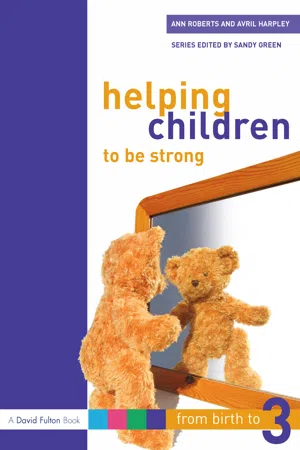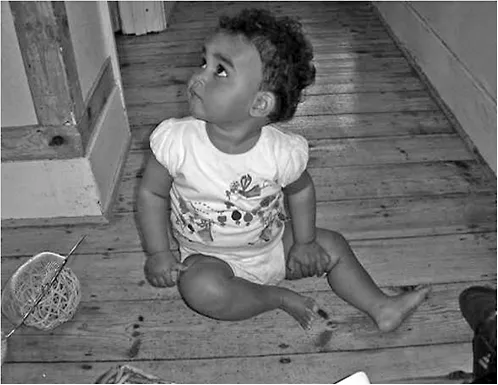
This is a test
- 96 pages
- English
- ePUB (mobile friendly)
- Available on iOS & Android
eBook - ePub
Helping Children to be Strong
Book details
Book preview
Table of contents
Citations
About This Book
This isn't about physical strength but about becoming a stronger person.
Helping Children to be Strong covers:
- me, myself and I
- being acknowledged and affirmed
- developing self-assurance
- a sense of belonging.
This handy little series of books links directly to the Government's Birth to Three Matters Framework (DfES 2002). It provides information and ideas for you to read and digest at your own pace, then implement or share with your team.
Frequently asked questions
At the moment all of our mobile-responsive ePub books are available to download via the app. Most of our PDFs are also available to download and we're working on making the final remaining ones downloadable now. Learn more here.
Both plans give you full access to the library and all of Perlego’s features. The only differences are the price and subscription period: With the annual plan you’ll save around 30% compared to 12 months on the monthly plan.
We are an online textbook subscription service, where you can get access to an entire online library for less than the price of a single book per month. With over 1 million books across 1000+ topics, we’ve got you covered! Learn more here.
Look out for the read-aloud symbol on your next book to see if you can listen to it. The read-aloud tool reads text aloud for you, highlighting the text as it is being read. You can pause it, speed it up and slow it down. Learn more here.
Yes, you can access Helping Children to be Strong by Ann Roberts,Avril Harpley in PDF and/or ePUB format, as well as other popular books in Education & Education General. We have over one million books available in our catalogue for you to explore.
Information
1
Me, myself and I
Introduction
The first chapter of this book, ‘Me, myself and I’, is about a period of self-discovery and focuses on the development of a child’s identity. By the time a child is ready to move on from pre-school he should have developed a secure sense of his own individuality, be aware of his strengths and understand that it is OK to be different.
The role of the practitioner centres on helping the child to develop positive relationships and a feeling of self-worth rather than expecting him to follow a curriculum. Without the security of good self-esteem, confidence and self-worth, formal learning may be delayed. These personal qualities are shaped by the reactions and responses of others as well as the child’s own expectations. Initially a child’s view of himself in the world is formed by the family who create beliefs, values and attitudes. Once babies and young children enter an early years setting/childcare they encounter a whole new range of behaviours, customs and reactions. This can be upsetting and confusing, although some children learn to live in two cultures at the same time. The situation is eased if practitioners support the children and help them to adjust by making the environment more like home. In order for this to happen practitioners need to work closely with parents/carers in order to understand the families’ background and culture. If a family has English as a second language, it is important to discover, and use, essential phrases such as greetings, and words used for physical needs: hunger, sleep and personal hygiene. In this way, they can get to know the children in their care, their interests and family expectations and support them more effectively.
Throughout this book there are sections for staff discussion. This is an important area where the adults can get to know how they each feel and think about the care and education of young children. Areas for reflection are the practitioner’s own concept of self-worth, their attitudes, values and prejudices and how this may affect their relationships with the children in their care.
1. Identity
Young babies become aware of themselves as separate from others, learning also that they have influence upon and are influenced others.
(Birth to Three Matters)

| Babies From birth, babies are interested in what is going on around them. During these early stages of development, the beginning of a sense of self and an awareness of their identity is closely linked to the responses of their parents and main carers. As they mature babies begin to realise that they are separate beings and individuals. This can be observed when babies use their sense of touch and taste; they suck and chew as they play with their hands and feet. Over time, they gain greater control of their body and mind and begin to understand these hands and feet are theirs and they can move them. Babies use their ability to cry to influence others and communicate their needs to parents and carers. |
| Practical activities • Place a treasure basket between two babies and observe carefully. Look for clues that indicate each child’s interest. Follow this up by creating a treasure basket for each child based on these observations. Use a luggage label containing the babies’ photograph to identify the baskets. • Focus on providing sensory activities that encourage babies to be aware of their hands and feet. For example, provide individual trays of sand and bowls for water play, place ice-cubes or aromas in the water, use soft feathers that tickle. Note how the babies explore these natural resources and how they respond to them.
• Create an area containing mirrors and position the babies so that they can see their own reflections. This is one way that demonstrates they have self-awareness and know ‘It’s me!’ • Observe babies’ expressions and actions when they attempt to influence others. Capture these significant moments on film. |
| Toddlers As babies mature and become toddlers their sense of self becomes stronger. It is essential that this is a positive experience. Feeling comfortable, or good, about oneself is the foundation for high self-esteem and influences a child’s position in society, his attitudes and his disposition for learning. It is the core of personal, social and emotional development. Practical activities • Identity is very important. Make name labels personal and specific to each child by including a photograph of the child along with a picture of an item of special significance, such as his teddy or his pet. Ask the child what he would like to include. Learn to pronounce and spell his name correctly. • Look for ways to show that you respect and value each child’s preferences, likes/dislikes and interests. For example, create a specific area where he can display his favourite things, listen carefully when he wants to share his news, be aware of what he likes to eat and who he likes to sit alongside. • Create a photo wall and have a safety mirror in the centre where the children can see their own reflections. • Place hats and scarves, clown noses or face paints beside a safety mirror so that the children can interact and try out different ‘faces’. Take photos of their ‘new look’. |
• Develop a time during the day when you come together in small groups to talk about their news, favourite things they have done during the day or would like to do. Help the children to develop their memory skills by recalling activities and events. • Set up a video loop of the children’s activities during the day and show this when parents/carers come to collect their children. Spend time talking with parents/carers pointing out the positive things their children have achieved. Alternatively create a picture/photo board of achievements with appropriate comments such as ‘I tied my laces today’ or ‘I played in the water with my friend’. |
| Outcomes for the child • Children understand that they have the power to make an impact on another. Focus points• Beginning to appreciate that they are unique. • Developing confidence. • Developing social qualities and forming friendships. If adults label a child’s behaviour or ... |
Table of contents
- Contents
- Acknowledgements
- Introduction
- 1 Me, myself and I
- 2 A sense of belonging
- 3 Being acknowledged andaffirmed
- 4 Developing self-assurance
- Conclusion
- Appendix: The Birth to Three Framework for ‘A Strong Child’
